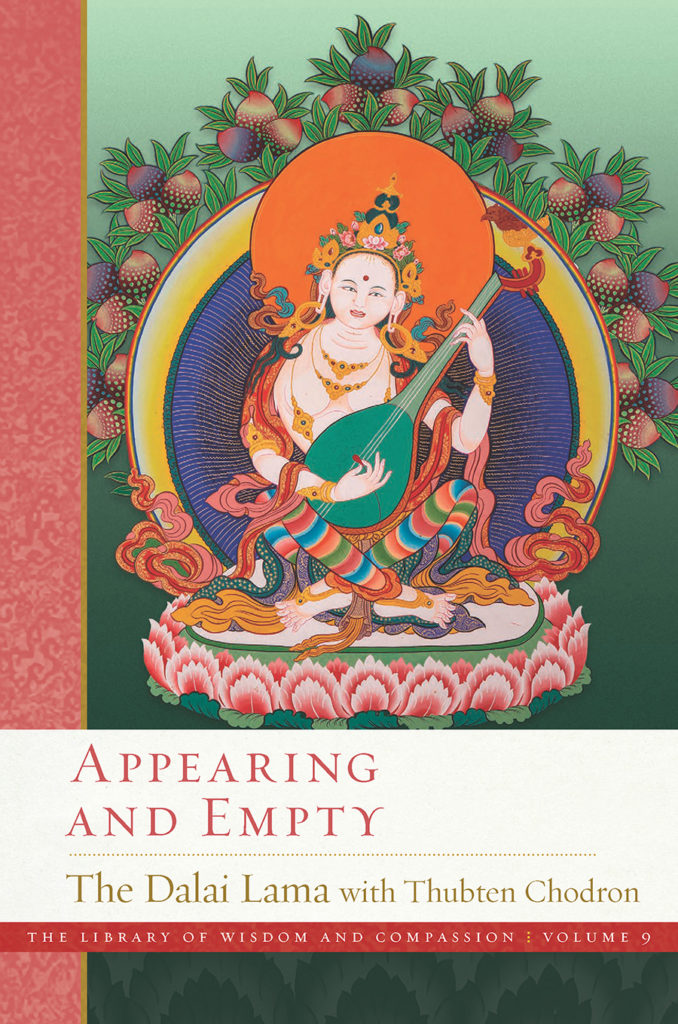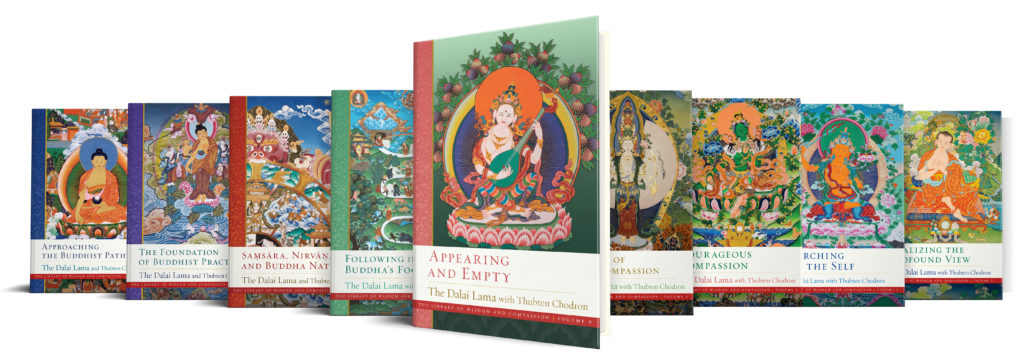The following is an excerpt from Appearing and Empty by His Holiness the Dalai Lama and Ven. Thubten Chodron, the newest volume in the Library of Wisdom and Compassion series.
The Two Truths
Looking at a person’s books tells us a lot about him or her. Sometimes the initial pages of the lamrim text are well worn, the pages in the middle less so, and the pages of the insight chapter are untouched. This person has become lazy when it comes to studying difficult topics and needs to put more energy into understanding them. Someone once told me that the subjects I teach are too difficult for the audience and asked me to teach something simpler. I replied that we need to learn and understand what we don’t already know, not just review the easier material that we are familiar with. Some texts are more concise when they arrive at the section on wisdom, but the texts of the great masters explain the difficult sections in more detail.
Studying many treatises and commentaries broadens our understanding, and it is worthwhile to wait to reach a firm conclusion until we have learned and contemplated the various assertions. By doing so, we will gain an understanding based on reasoning, which will strengthen our practice and enable our meditation to be successful. Without this, we may spend years doing retreat in a secluded place and emerge only to find that our minds have not been transformed very much. So let’s galvanize our joyous effort and delve into the topic of the two truths.
Introduction to the Two Truths
The topic of the two truths—veiled truths (saṃvṛtisatya) and ultimate truths (paramārthasatya)—comes up in several different contexts. In the context of the four truths, true cessations are ultimate truths, whereas the other three truths are veiled truths. In the context of dependent arising and emptiness, dependent arising principally, although not exclusively, relates to veiled truths, whereas emptinesses are ultimate truths. In the context of method and wisdom, the method aspect of the path, the collection of merit, and the form body of a buddha are related to conventional truths, whereas the wisdom aspect of the path, the collection of wisdom, and the nature truth body are related to ultimate truths.
The topic of the two truths is important for several reasons. First, it helps us to understand that the everyday functioning of people and things in the world is compatible with their emptiness of objective existence. Dependent arising and emptiness are not only compatible but also mutually reinforce each other. Emptiness does not negate veiled truths such as karma and its effects or the method side of the path. Although all phenomena lack inherent existence, maintaining excellent ethical conduct is of crucial importance and the bodhisattva conduct of engaging in compassionate action is essential for attaining awakening. In fact, cause and effect can function only in a world in which everything is empty of inherent existence.
Second, the two truths are different objects and understanding both is valuable, useful, and necessary to attain awakening. Understanding them helps us balance and combine the practice of the method aspect of the path and the wisdom aspect of the path. Although the realization of phenomena’s ultimate nature—their emptiness of inherent existence—will liberate us from saṃsāra, it does not inform us as to how things interrelate and operate conventionally. If we need directions to go to Delhi, veiled truths such as a map, signposts, and a vehicle will fulfill that need, whereas ultimate truths will not. To function effectively and with compassion in the world, an understanding of both truths is essential.
Someone who remains absorbed in the direct realization of ultimate truth may be free from saṃsāra but will not have all the skills needed to function in the world, let alone to benefit others. On the other hand, those who are totally immersed in the details of veiled truths will reify situations, be distracted from learning about ultimate truth, and afflictions will easily arise in their minds. To fulfill their own and others’ aims, bodhisattvas seek knowledge of both truths.
Please read this and the following chapters carefully. The way words are used in the topic of the two truths is very specific. One term can have multiple meanings depending on the context. For example, “real” and “real for the world” have different meanings. Veiled or conventional truths are not true. Emptiness is true—it is an ultimate truth—but it doesn’t exist ultimately or truly. Understanding the meaning behind these words reveals many nuances that refine our understanding of emptiness and dependent arising.
. . .
"An understanding of both truths is essential."
Buddhist Tenet Systems and the Two Truths
The topic of the two truths is common to many classical Indian philosophical traditions, both Buddhist and non-Buddhist, although how the two truths are defined differs. When we understand the order of the Buddhist tenet systems as the way for practitioners to gradually develop more profound views, the array of views concerning the two truths becomes clearer. For Vaibhāṣikas, a veiled truth is a phenomenon that, when physically broken down or mentally isolated into parts, can no longer generate a consciousness knowing that object. A person and a table are examples of veiled truths. If you break the table into parts, you no longer see a table there. An ultimate truth is an object that, no matter how it is broken down physically or isolated into parts mentally, still generates the thought of that object. Directionally partless particles, temporally partless moments of mind, and unproduced space are examples of ultimate truths.
For Sautrāntika—specifically Sautrāntika Reasoning Proponents—a phenomenon that is ultimately able to perform a function is an ultimate truth, and a phenomenon that is not ultimately able to perform a function is a veiled truth. Unlike other Buddhist systems, they say all impermanent things—such as a person and a table—are ultimate truths because they ultimately perform a function. In this view, veiled truths are imputations—permanent phenomena such as permanent space, conceptual appearances, and true cessations.
According to Yogācārins, an ultimate truth is a phenomenon that is the final object of awareness of the path of purification. It is realized by a direct reliable cognizer that realizes it clearly without dualistic appearance; emptiness, consummate phenomena such as true cessations, and suchness are ultimate truths. All other phenomena, such as tables and persons, are veiled truths.
For Svātantrika Mādhyamikas, veiled truths are objects that are realized with dualistic appearance by their reliable cognizers, whereas ultimate truths are those realized by direct reliable cognizers by the vanishing of dualistic appearances. Chairs, tables, persons, and conceptual appearances are examples of veiled truths, while the emptiness of true existence is ultimate truth.
According to Prāsaṅgika Mādhyamikas, veiled truths—also called conventional or nominal truths—are objects found by a conventional reliable cognizer perceiving a false knowable object.
The definitions of the two truths for the Vaibhāṣikas and Sautrāntikas have to do with how or if objects function in the world. The definitions for the Yogācārins and Mādhyamikas are related to how phenomena exist, the type of cognizers that apprehend them, and how they appear to those minds.
REFLECTIONS
- What are the two truths? What are some of the defining characteristics of each truth?
- What are the benefits of understanding the two truths? What are the drawbacks of not understanding them correctly?
"The topic of the two truths is common to many classical Indian philosophical traditions . . ."
In Appearing and Empty the Dalai Lama skillfully reveals the Prāsaṅgikas’ view of the ultimate nature of reality so that we will gain the correct view of emptiness, the selflessness of both persons and phenomena, and have the means to eliminate our own and others’ duḥkha.
In this last of three volumes on emptiness, the Dalai Lama takes us through the Sautrāntika, Yogācāra, and Svātantrika views on the ultimate nature of reality and the Prāsaṅgikas’ thorough responses to these, so that we gain the correct view of emptiness—the selflessness of both persons and phenomena. This view entails negating inherent existence while also being able to establish conventional existence: emptiness does not mean nothingness. We then learn how to meditate on the correct view by cultivating pristine wisdom that is the union of serenity and insight as taught in the Pāli, Chinese, and Tibetan traditions. Such meditation, when combined with the altruistic intention of bodhicitta, leads to the complete eradication of all defilements that obscure our minds. This volume also introduces us to the tathāgatagarbha—the buddha essence—and how it is understood in both Tibet and China. Is it permanent? Does everyone have it? In addition, the discussion of sudden and gradual awakening in Zen (Chan) Buddhism and in Tibetan Buddhism is fascinating.
“The Library of Wisdom and Compassion is a treasure trove for modern students of the Buddhadharma. In Appearing and Empty, His Holiness the Dalai Lama and Venerable Thubten Chodron take us systematically through one of the most nuanced and challenging topics in Buddhism: emptiness. Providing explanations from the point of view of various Tibetan Buddhist tenet systems and incorporating commentaries from the Pāli and Chinese traditions, this book is a must-read for those eager to comprehend the profound meaning of the two truths.” —Jetsunma Tenzin Palmo, founder of the Dongyu Gatsal Ling Nunnery
The Library of Wisdom and Compassion is a special multivolume series in which His Holiness the Dalai Lama shares the Buddha’s teachings on the complete path to full awakening that he himself has practiced his entire life. The topics are arranged especially for people seeking practical spiritual advice and are peppered with the Dalai Lama’s own unique outlook. Assisted by his long-term disciple, the American nun Thubten Chodron, the Dalai Lama sets the context for practicing the Buddha’s teachings in modern times and then unveils the path of wisdom and compassion that leads to a meaningful life and sense of personal fulfillment. This series is an important bridge from introductory to profound topics for those seeking an in-depth explanation from a contemporary perspective.
| There are no products in your cart. |


